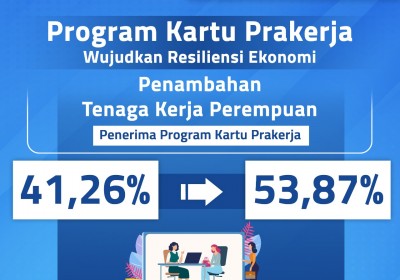Preemployment Card Program Showing the Resilience of Indonesian Economy
November 24, 2021
JAKARTA – In order to minimize the economic and productivity stagnation caused by the Covid-19 pandemic, the government launched the Preemployment Card Program (PKP) during the initial months of the pandemic.
To evaluate the effects of the program, the Center for Strategic International Studies (CSIS) conducted a survey between 27 July to 2 August 2021, collecting 2,000 random samples from the program’s database using the stratified random sampling method. The samples are taken accordingly in order to determine the proportion of samples with the number of KP recipients across 34 provinces and also takes the genders of the subjects into consideration. The margin of error of this survey is at +/- 2.19%, with a confidence rate of 95% and was conducted mainly through telephone surveys to KP recipients.
The results of the survey showed that KP recipients experienced improved economic conditions after taking part in the program. This is indicated by the improved income rates of the subjects recorded, despite the economic effects of the Covid-19 pandemic. Also, the improvement of economic conditions can also be attributed to the number of new businesses opened during the pandemic period and the improved productivity rates of KP recipients.
The KP program provides post-training incentives, namely intensive semi-social assistance programs for recipients to both cushion them and the economy to become more resilient. CSIS findings indicate that around 86.7% of recipients used the incentives to purchase basic necessities and food. Meanwhile, 10.5% saved their incentives in banks while 77.3% saved it for immediate emergency funds.
These figures indicate that the incentives provided are quite well-targeted, namely as an economic cushion for primary needs and also as financial resources for the future. In this regard, 78.1% of recipients stated that the Rp 600,000 incentives they are given by the program could help them meet their domestic needs for a month.
Also, KP incentives have helped provide financial liquidity in the midst of the pandemic. As indicated by the data, up to 75.8% of respondents withdrew their incentive funds right after receiving them, with 81.5% stating that they needed the funds as soon as possible. The data collected from the survey are sufficient enough to describe the role of the KP program’s incentives as social safety nets for many.
The program also saw the addition of new workers/entrepreneurs out of the number of KP recipients, from the previous 49.1% to the current 62.4%. In other words, this program has opened up opportunities for recipients to earn a living after participating in the program, even in the midst of dire economic conditions. This also supports the fact that 85.6% of recipients have become more competitive in the labour market. Even so, the KP program is expected to be able to act as a job-connecting mechanism in the future for its recipients, so that all would feel fully supported to apply their new skills in a career.
Other notable findings include an increase in female workers, from 41.26% of recipients to 53.87%. Meanwhile, the average income rate increased in a number of income groups including female recipients. These findings show that female recipients are able to increase their productivity at a faster rate after receiving training, accompanied by the addition of new female workers who have productivity levels equal to or even higher than the general number of working females before participating in the program.
Indonesia’s Research Institutions Supporting the Development of the Electric Vehicle Industry
Indonesian Muslim Fashion and Cosmetics IKMs Shine at Dubai World Expo 2020
Govt Steps Up UMKM Transformation Efforts in the Midst of Pandemic Slowdown
Govt Encourages Promotion of IKM Products in Digital Era
Government Begins Developing Maritime Training Center in Makassar
Tweets by IDDevForum
